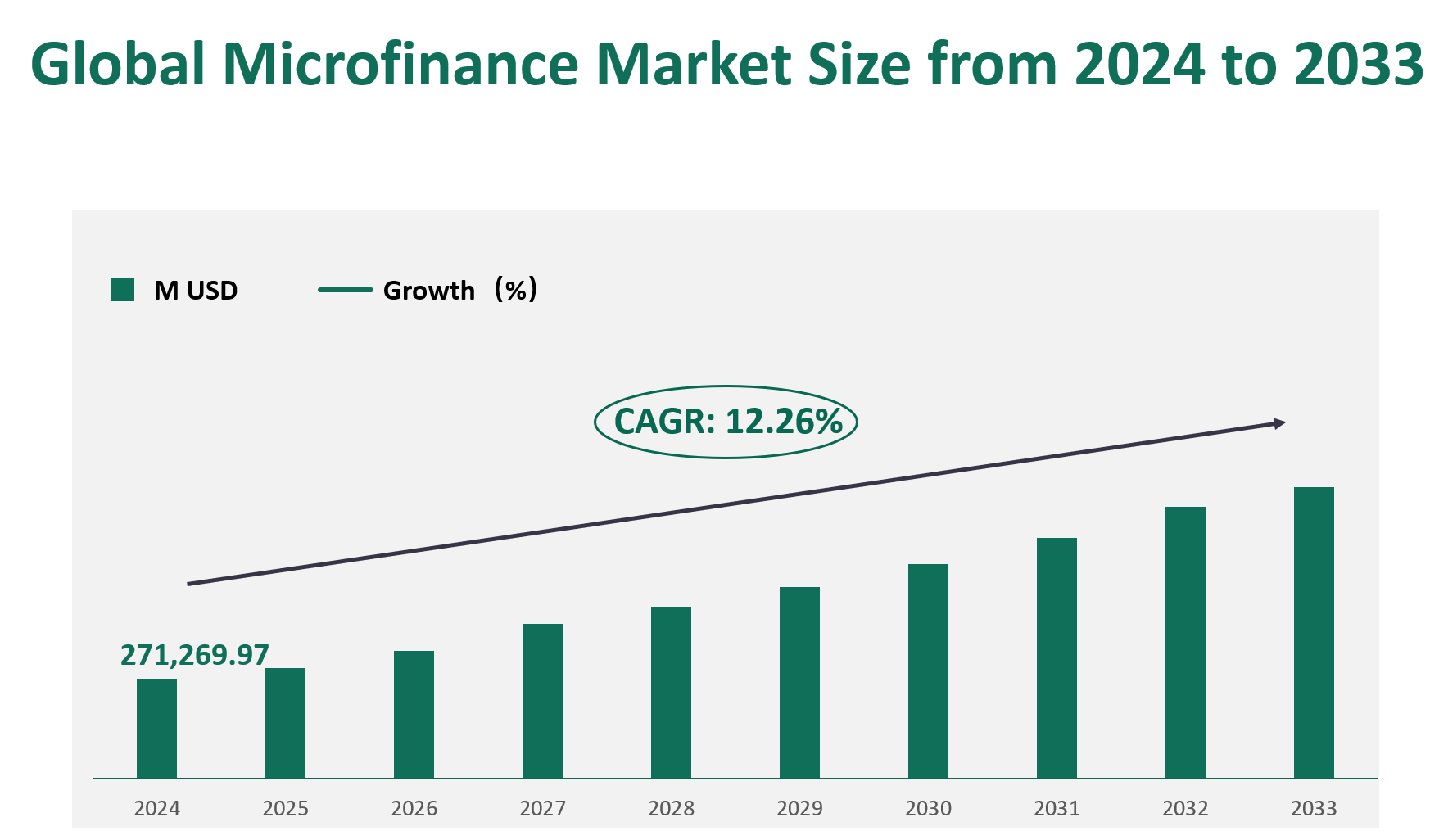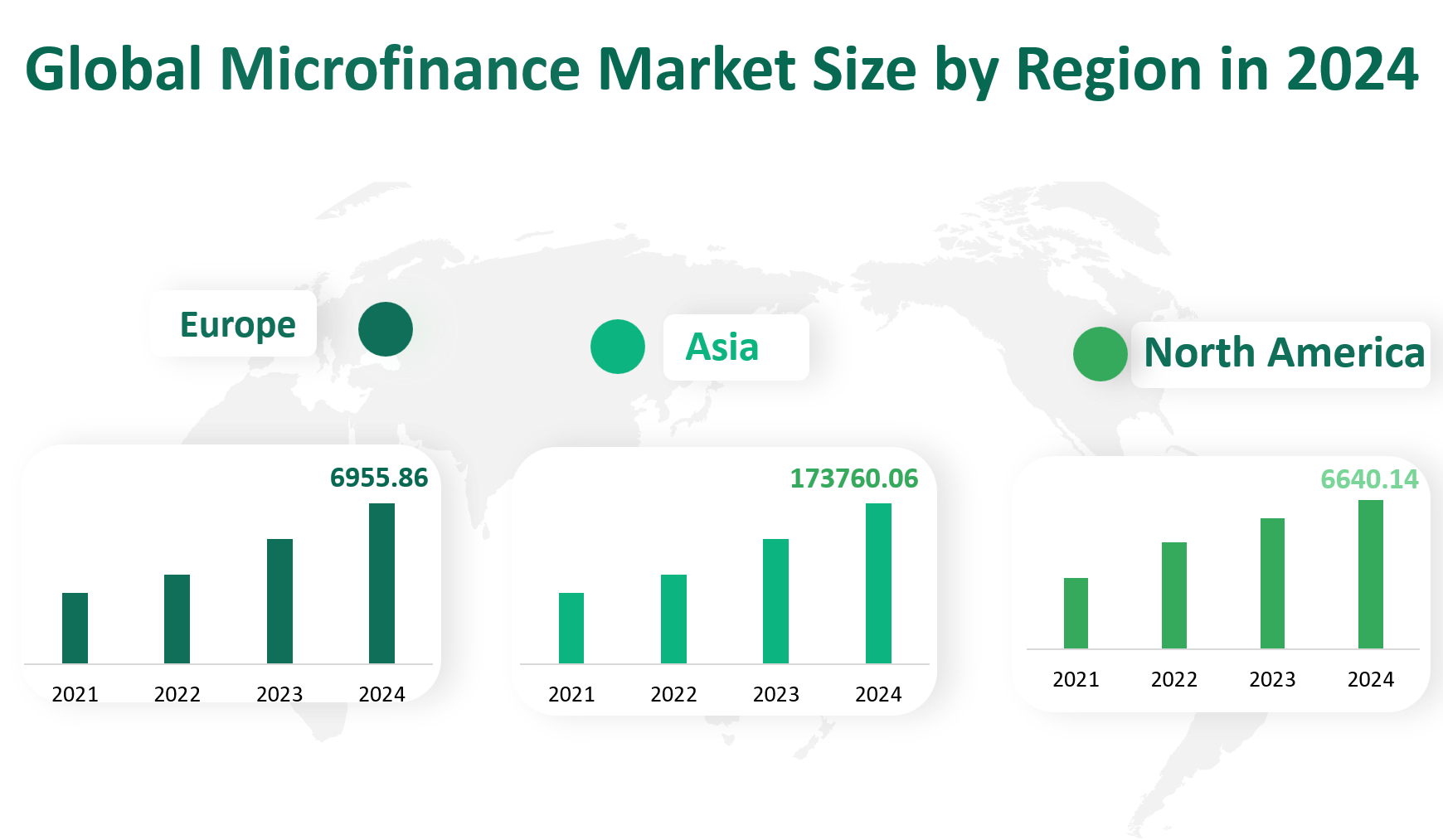1. Global Microfinance Market Insight Analysis
The global microfinance market is projected to reach a value of $271,269.97 million (M USD) in 2024, with a compound annual growth rate (CAGR) of 12.26% from 2024 to 2033.
Microfinance, as a financial service, is designed to provide small loans and other financial services to individuals and small businesses who lack access to traditional banking systems. This sector primarily targets low-income individuals, micro-entrepreneurs, and small businesses, often in developing countries. By offering microloans, micro-savings, and micro-insurance, microfinance institutions (MFIs) aim to support economic development, reduce poverty, and promote financial inclusion. The concept of microfinance was popularized by institutions like Grameen Bank, which pioneered the idea of providing small, collateral-free loans to the poor, enabling them to start or expand their businesses.
Microfinance operates on the principle that even small amounts of credit can significantly impact poverty alleviation and economic empowerment. It is particularly effective in rural and underserved areas where traditional financial institutions are reluctant to operate due to the perceived high risks and low profitability. Microfinance institutions often rely on group lending models, where borrowers form groups to provide mutual support and accountability, reducing the risk of default. This approach has been successful in many regions, fostering a sense of community and shared responsibility among borrowers.
Figure Global Microfinance Market Size (M USD) and CAGR (2024-2033)

2. Driving and Limiting Factors of Microfinance Market Growth
Financial Inclusion: A significant portion of the global population, particularly in developing countries, lacks access to formal financial services. Microfinance fills this gap by providing essential financial tools to underserved communities, enabling them to participate in economic activities.
Poverty Alleviation: Microloans empower individuals to start or expand small businesses, generating income and improving their quality of life. This has a direct impact on poverty reduction and economic stability.
Technological Advancements: The rise of digital financial services has revolutionized microfinance. Mobile banking, digital wallets, and online lending platforms have made it easier and more efficient for MFIs to reach remote areas and serve a larger number of clients.
Government Support: Many governments recognize the importance of microfinance in promoting economic development and have implemented policies to support the sector. This includes regulatory frameworks that encourage the establishment of MFIs and the provision of subsidies or grants to support microloans.
High Interest Rates: To cover operational costs and risks, MFIs often charge relatively high interest rates on loans. This can be a burden for borrowers, especially those already struggling financially.
Regulatory Challenges: While supportive regulations are crucial, overly stringent regulations can stifle innovation and limit the reach of micro-finance services. Balancing regulation with flexibility is a challenge for policymakers.
Credit Risk: The target clients of microfinance are often individuals with limited financial history or collateral. This increases the risk of default, which can be a significant concern for MFIs.
Scalability: Expanding micro-finance services to a larger scale requires significant resources and infrastructure. Many MFIs face challenges in scaling their operations while maintaining profitability and sustainability.
3. Technology Innovation in Microfinance Market
Digital Platforms: The integration of mobile banking and digital platforms has transformed how micro-finance services are delivered. These platforms reduce operational costs, enhance accessibility, and improve the efficiency of loan disbursement and repayment processes.
Big Data and Analytics: MFIs are leveraging big data and analytics to better assess creditworthiness, manage risks, and tailor financial products to meet the specific needs of their clients. This data-driven approach enhances decision-making and reduces the likelihood of defaults.
Blockchain Technology: Blockchain offers a secure and transparent way to manage financial transactions, reducing fraud and increasing trust in microfinance operations. It also enables cross-border transactions, expanding the reach of micro-finance services globally.
4. Global Microfinance Market Size by Type
Microfinance encompasses a variety of financial products tailored to meet the needs of low-income individuals and small businesses. The primary product types include Group and Individual Micro Credit, Leasing, Micro Investment Funds, Insurance, Savings and Checking Accounts, and Others.
Group and Individual Micro Credit is the cornerstone of microfinance, offering small loans to individuals or groups to support income-generating activities. These loans are designed to be accessible to those with limited collateral and often come with flexible repayment terms. In 2024, the market value for Group and Individual Micro Credit is projected to reach $148,073.02 million.
Micro-leasing provides low-income individuals and micro-entrepreneurs with access to relatively low-cost equipment to enhance their economic livelihood. This product type is especially beneficial for those who need to acquire capital goods but lack the financial resources for outright purchase. The market value for leasing in 2024 is forecasted to be $20,870.94 million.
Micro Investment Funds allow individuals to invest in small increments, often through the purchase of fractional shares. These funds eliminate per-transaction fees and investment minimums, making investing more accessible to low-income individuals. The market value for Micro Investment Funds in 2024 is expected to be $27,712.63 million.
Micro insurance offers protection to low-income individuals against specific perils in exchange for regular premium payments. These products cover a range of risks, including health, property, and natural disasters. The market value for micro insurance in 2024 is projected to be $25,417.11 million.
Micro savings and checking accounts provide a secure way for individuals to save and manage their finances. These accounts often require minimal balances and offer flexible deposit and withdrawal options. The market value for Savings and Checking Accounts in 2024 is forecasted to be $42,340.02 million.
Table Global Microfinance Market Size by Type in 2024
Market Size (M USD) 2024 | Market Share | |
Group and Individual Micro Credit | 148073.02 | 54.59% |
Leasing | 20870.94 | 7.69% |
Micro investment Funds | 27712.63 | 10.22% |
Insurance | 25417.11 | 9.37% |
Savings and Checking Accounts | 42340.02 | 15.61% |
Others | 6856.26 | 2.53% |
5. Global Microfinance Market Size by Application
Microfinance applications can be broadly categorized into two main segments: Banks and Non-banks.
Banks are traditional financial institutions that offer a range of micro-finance services, including loans, savings accounts, and insurance products. They play a crucial role in providing formal financial services to underserved populations. In 2024, the market value for Banks in the microfinance sector is projected to be $144,397.01 million. Banks leverage their existing infrastructure and regulatory compliance to offer micro-finance products at scale.
Non-bank financial institutions (NBFIs) include microfinance companies, credit unions, and other organizations that provide financial services outside the traditional banking system. These institutions often focus on niche markets and offer more flexible and innovative financial products. The market value for Non-banks in 2024 is forecasted to be $126,872.97 million. NBFIs are particularly important in regions where traditional banking services are limited or inaccessible.
Table Global Microfinance Market Size by Application in 2024
Application | Market Size (M USD) 2024 | Market Share |
Banks | 144397.01 | 53.23% |
Non-banks | 126872.97 | 46.77% |
6. Global Microfinance Market by Top Regions
Asia is projected to be the largest regional market for microfinance in 2024, with a market value of $173,760.06 million. This region’s dominance is driven by its vast population, rapid economic growth, and significant unmet demand for financial services. The expansion of digital financial services and government initiatives to promote financial inclusion have further fueled the growth of microfinance in Asia. For example, India’s microfinance sector has seen significant expansion through both traditional MFIs and digital platforms, making financial services accessible to millions of underserved individuals.
South America is the second-largest regional market, with an estimated value of $67,586.48 million in 2024. Brazil and Colombia are key players in this region, contributing significantly to the overall market size.
Africa’s microfinance market is expected to reach $15,368.26 million in 2024. The region’s market is characterized by high demand for financial services, particularly in rural areas. Countries like Nigeria and Kenya have seen significant growth in micro-finance, driven by government support and the expansion of mobile banking services.
Europe’s microfinance market is projected to be worth $6,955.86 million in 2024. While relatively smaller compared to Asia and South America, Europe’s market is characterized by a high level of financial inclusion and a focus on social impact. The region’s microfinance sector is driven by non-governmental organizations (NGOs) and specialized microfinance institutions that target marginalized communities.
North America’s microfinance market is expected to reach $6,640.14 million in 2024. The region’s market is characterized by a mix of traditional financial institutions and fintech companies offering microfinance services. The United States and Canada are the main markets, with a focus on supporting small businesses and entrepreneurs. The regulatory environment is supportive, with initiatives like the Paycheck Protection Program (PPP) providing significant support to microfinance during economic downturns.
Figure Global Microfinance Market Size by Region in 2024

7. Global Microfinance Market Analysis by Major Players
7.1 Grameen Bank (Bangladesh)
Introduction and Business Overview: Grameen Bank, founded in 1983 by Muhammad Yunus, is a pioneering microfinance institution based in Bangladesh. The bank’s mission is to provide small loans to the impoverished without requiring collateral, promoting economic self-sufficiency and poverty alleviation. Grameen Bank operates on the principles of trust and community support, with a focus on empowering women and marginalized communities.
Products Offered: The bank offers a range of microfinance products, including microloans for income-generating activities, micro-savings accounts, and micro-insurance. These services are designed to support small businesses and entrepreneurial activities, enabling borrowers to improve their economic conditions.
7.2 Banco Do Brasil (Brazil)
Introduction and Business Overview: Banco Do Brasil is a leading financial institution in Brazil, offering a wide range of banking services, including microfinance. Established in 1808, the bank has a strong presence across the country and plays a crucial role in supporting small businesses and rural communities.
Products Offered: Banco Do Brasil provides microloans for working capital, investment in equipment, and other business needs. The bank also offers micro-savings accounts and insurance products, catering to the diverse financial needs of its clients.
7.3 FINCA International (USA)
Introduction and Business Overview: FINCA International is a non-profit microfinance organization founded in 1984. The organization operates in multiple countries, providing financial services to underserved communities. FINCA’s mission is to empower individuals through access to financial tools and services, promoting economic independence and social development.
Products Offered: FINCA offers a range of microfinance products, including microloans, micro-savings, and micro-insurance. The organization also provides financial literacy training and business development services to support its clients’ entrepreneurial activities.

